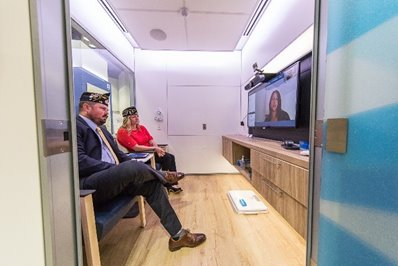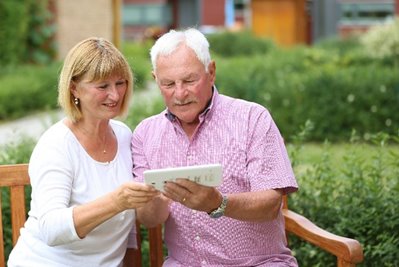Extending quality care into every American community
These crises have put rural healthcare at a crossroads, and patients and care providers alike are demanding change in terms of where and how care is delivered.
As health equity remains top of mind for many in the health industry, we mustn’t ignore location and regional access as a barrier to care.
Meeting patients where they are
Extending care delivery to everyone – no matter where they live and work – will reach more of the people who need it most. Many of the communities who reside in rural areas, including active-duty military members and veterans, American Indians and Native Alaskans and people receiving Medicaid and Medicare benefits, were experiencing twice as many deaths due to COVID-19 as urban neighborhoods by late 2020[6]. This makes it of utmost importance to respond urgently with care solutions.
Historically, extending care meant accepting trade-offs in precision and accuracy – but with the cutting-edge solutions available today, quality care is possible for everyone.
Telehealth can facilitate regular checkups and remote monitoring for people managing chronic illness while providing timely intervention for those at risk. Use of telehealth has massively accelerated in the wake of COVID-19, with a 154 percent increase in telehealth visits between March 2019 and March 2020.[7] It isn’t just about bringing care solutions into the home, but instead bringing people to the care they deserve.
One of the best case studies we’ve seen recently is telehealth use within the Native community. The Lummi Tribal Health Center relies on telehealth to administer virtual physical therapy sessions, complete dermatology appointments and host behavioral health sessions, among other services. The Health Center saw increased involvement and improved satisfaction with their behavioral health offerings once virtual, as the online space can provide more privacy to patients who might otherwise have chosen to skip due to inconvenience or stigma[8].
But with only 72 percent of rural communities reporting access to broadband[9] and some rural families even having limited access to power and water, offering care solutions in the home is not always an option. This pushes providers to innovate further – and they do.
The Lummi Tribal Health Center set up virtual care offerings in their parking lots and delivered Wi-Fi hotspots and tablets to patients’ homes. For patients without connectivity at home, virtual care sites are a convenient option and can also be useful in disrupted healthcare environments.

Quality healthcare regardless of location
The U.S. Department of Veterans Affairs (VA) provides healthcare to nearly nine million veterans, one-third of whom live in rural areas. Geographic and digital divides can make it challenging for rural veterans to get the care they need. VA’s Accessing Telehealth through Local Area Station (ATLAS) program brings care to veterans in places they already visit, namely Veterans of Foreign Wars and American Legion posts. In a private, clinical-grade environment, these stations allow veterans to be examined at their local post through virtual appointments with medical professionals across the nation – saving veterans endless highway hours and travel expenses.[10] More recently, Philips has partnered with VA to roll out a Tele-Critical Care program, which will be one of the world’s largest systems and provide veterans remote access to intensive care expertise such as eICU, diagnostic imaging and sleep solutions, regardless of location.[11]
Connecting rural communities to quality care also relies on innovative technology and portability. With Philips Lumify, a point-of-care ultrasound (PoCUS), providers can take the high-quality ultrasound almost anywhere to help evaluate and manage patients in respiratory distress, a crucial tool particularly over the last year and a half of the pandemic.
Recently, Philips has joined with the UCSF Health Equity, Action & Leadership Initiative and Navajo Nation to offer PoCUS training to local fellows on the reservation. The project has two primary goals: train providers for independent use of PoCUS and give providers the tools needed to train other providers in their rural communities. This tiered training model is crucial to ensure continued access to ultrasound care for Navajo Nation even as barriers to connectivity or travel arise, allowing community members to be cared for by providers they know and trust, closer to home.

The future relies on partnership
The demand for extended care solutions across rural America is expected to grow, driven by ongoing concerns of COVID-19, an aging population and a rise in chronic conditions, among other factors.
Looking to the future, healthcare stakeholders must remember the right solution may not be an extension or reinvention of what already exists, but instead a new technology that completely leapfrogs the current understanding of care delivery. With creative thinking and perseverance, communities that may seem to be lacking in certain resources can prove integral to public health progress, as we’ve seen witnessed with the Navajo Nation vaccine rollout[12]. What we innovate now can strengthen rural communities’ care delivery models for years to come.
In almost every case, extended care also depends on partnerships of many types and sizes – partnerships between companies and health systems, among patients and providers and across state lines.
At Philips, strategic growth starts with listening to partners to identify the root cause of challenges. Clinical, operational and technical solutions are tailored to each provider’s and community’s needs, because it’s clear that healthcare transformation is not one-size-fits-all. Taking a holistic and long-term approach to rural community care now, we can all work together to future-proof medicine and find ways to deliver the highest-quality care to everyone, no matter where they live.
NRHA adapted the above piece from Philips, a trusted NRHA partner, for publication within the Association’s Rural Health Voices blog
[1] What is Rural America? The United States Census Bureau. (2019, May 23). https://www.census.gov/library/stories/2017/08/rural-america.html.
[2] Centers for Disease Control and Prevention. (2021, May 4). Rural Communities. Centers for Disease Control and Prevention. https://www.cdc.gov/coronavirus/2019-ncov/need-extra-precautions/other-at-risk-populations/rural-communities.html
[3] What is Rural America? The United States Census Bureau. (2019, May 23). https://www.census.gov/library/stories/2017/08/rural-america.html.
[4] Centers for Disease Control and Prevention. (2021, May 4). Rural Communities. Centers for Disease Control and Prevention. https://www.cdc.gov/coronavirus/2019-ncov/need-extra-precautions/other-at-risk-populations/rural-communities.html.
[5] Hartnett KP, Kite-Powell A, DeVies J, et al. Impact of the COVID-19 pandemic on emergency department visits — United States, January 1, 2019–May 30, 2020. MMWR. 2020;69(23):699-704. https://www.cdc.gov/mmwr/volumes/69/wr/mm6923e1.htm
[6] Jones, B., & Kiley, J. (2021, May 25). The Changing Geography of COVID-19 in the U.S. Pew Research Center - U.S. Politics & Policy. https://www.pewresearch.org/politics/2020/12/08/the-changing-geography-of-covid-19-in-the-u-s/.
[7] Koonin LM, Hoots B, Tsang CA, et al. Trends in the Use of Telehealth During the Emergence of the COVID-19 Pandemic — United States, January–March 2020. MMWR Morb Mortal Wkly Rep 2020;69:1595–1599. DOI: http://dx.doi.org/10.15585/mmwr.mm6943a3
[8] Grandbois, Donna. “STIGMA OF MENTAL ILLNESS AMONG AMERICAN INDIAN AND ALASKA NATIVE NATIONS: HISTORICAL AND CONTEMPORARY PERSPECTIVES.” Issues in Mental Health Nursing, 26:1001–1024, 2005. http://cretscmhd.psych.ucla.edu/healthfair/PDF%20articles%20for%20fact%20sheet%20linking/Stigma_mentalillness_AIAN.pdf
[9] Pew Research Center. (2021, April 26). Demographics of Internet and Home Broadband Usage in the United States. Pew Research Center: Internet, Science & Tech. https://www.pewresearch.org/internet/fact-sheet/internet-broadband/. Set fourth graph « Who has home broadband » to sort by « Community » and hover over « Rural » line to see statistic.
[10] https://www.usa.philips.com/healthcare/government/our-approach/partnerships-and-collaborations/atlas
[11] https://www.usa.philips.com/a-w/about/news/archive/standard/news/press/2020/20200708-va-selects-philips-to-create-worlds-largest-tele-critical-care-system-further-integrating-telehealth-and-delivering-quality-care-for-veterans.html
[12] Treisman, R. (2021, April 26). Outpacing The U.S., Hard-Hit Navajo Nation Has Vaccinated More Than Half Of Adults. NPR. https://www.npr.org/sections/coronavirus-live-updates/2021/04/26/990884991/outpacing-the-u-s-hard-hit-navajo-nation-has-vaccinated-more-than-half-of-adults.
